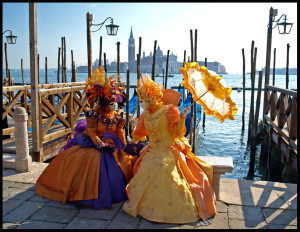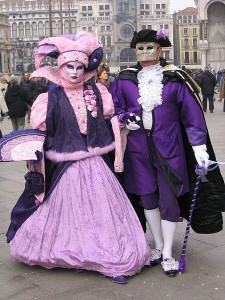Carnival, a Timeless Venetian Tradition
Posted on September 19th, 2013 by Anna in Uncategorized | No Comments »
 Carnival, the season of festivities leading up to the forty days of Lent in the Catholic calendar, is renowned for being one of the wildest, most indulgent onslaught of culturally-sanctioned partying possibly anywhere. Traditionally beginning on St. Stephen’s Day and lasting until Shrove Tuesday, (the day before Ash Wednesday,) Carnival has been embraced by countries internationally. However, no city embodies Carnival more completely than Venice. (Except for New Orleans, but Mardi Gras as celebrated by Louisiana is more of a New World phenomenon.)
Carnival, the season of festivities leading up to the forty days of Lent in the Catholic calendar, is renowned for being one of the wildest, most indulgent onslaught of culturally-sanctioned partying possibly anywhere. Traditionally beginning on St. Stephen’s Day and lasting until Shrove Tuesday, (the day before Ash Wednesday,) Carnival has been embraced by countries internationally. However, no city embodies Carnival more completely than Venice. (Except for New Orleans, but Mardi Gras as celebrated by Louisiana is more of a New World phenomenon.)
Carnival has a rich history dating back to medieval Italy, when “la Repubblica della Serenissima” was the wealthiest and most cosmopolitan city in Europe. In the 12th century, Lent was the most austere time of the year in which people were compelled to practice abstinence, fasting, and prayer for forty days until Easter, symbolizing the time Jesus spent fasting in the desert. Because eating meat during Lent was forbidden by the Catholic Church, (a practice which dates back to the early Church’s ties to the fishing industry,) it made sense for the Venetians to throw a week of parties to get rid of their excess meats and rich foods before the season of penitence. The term “carnival” dates back to the phrase carne vale, which means “farewell to meat” in Late Latin, with the dual significance of “farewell to the flesh,” which alludes to the state of abstinence in favor of a more spiritual outlook.
Venice’s iconic Carnival masks are recognizable around the world, with traditional Venetian mascherari, or mask-makers, having a highly esteemed guild in Renaissance Italy. In the 13th century, wearing masks was so popular in Venice that laws were passed regulating their use. Masks were forbidden while gambling or while visiting convents, and soon their presence dwindled to masquerade balls and other festivals, most notably Carnival. Wearing masks permitted all kinds of taboo activities to take place with safety to their perpetrators’ identities, such as gender-swapping and sexual liaisons between members of different social classes. Today, Venice’s stunning and intricate masks are as beloved as ever, with many varieties on display in the ubiquitous Venetian mask shops.
The bauta is the classic full-face mask, traditionally gilded and worn with a black cape, which assures complete anonymity to its wearer. The Columbina is a mask for the top half of the face, decorated with crystals and feathers, and there exist many other distinctive masks based on different characters of the Commedia dell’arte performance style such as Arlecchino and Pantalone. The Medico della peste mask is the surreal, bird-like mask with a long, sculpted beak, a reference to the plague doctors who thought wearing such frightening disguises would scare off the evil spirits that caused the bubonic plague.
These grotesque masks are a reminder of the darker aspects of Carnival, which came into being in a society ravaged by the Black Death. The “eat, drink, and be merry, for tomorrow we die,” mindset was a key contributor to the excesses of Carnival; when you and everyone you knew could be dead in a few days, it made perfect sense to enjoy yourself with dances, feasts, and debauches while you still could.
Although its religious and end-of-the-world significance has mostly vanished over the centuries, Carnival still exerts an enormous amount of influence in the modern world. Edgar Allan Poe found inspiration in the garish, macabre aspects of Carnival, which he conveyed perfectly in his stories “The Cask of Amontillado,” and “The Mask of the Red Death.” Every year Carnevale di Venezia attracts up to 3,000,000 tourists and revelers, proving that, despite its decay since its Renaissance heyday, Venice still stands as a paragon of romance and mystery the world over.





